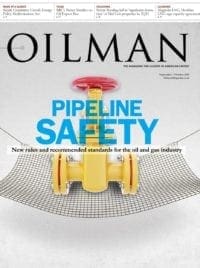Safety materials co-developed by the Texas Oil & Gas Association (TxOGA), Texas Mutual, the National Institute for Occupational Safety (NIOSH), and Occupational Safety and Health Administration (OSHA) will be an integral part of TxOGA’s presence December 9-11 at the 2015 Houston Oilfield Expo.
The programs, developed by the agencies above as the Oil & Gas Safety Roundtable, are free resources to act as road maps for small companies who may not have the staff or the budget to develop an extensive safety program. A study conducted by NIOSH suggests that small businesses need these types of resources the most: workers employed by smaller companies are five times more likely to be killed on the job than those working for companies that employ 50 or more people.
The most recently developed programs address two of the biggest safety challenges facing the oil and gas industry: motor vehicle accidents and untrained short service employees (SSE’s).
Training Solutions to Reduce Motor Vehicle Fatalities
The NIOSH study found that operators and well servicing professionals are almost twice as likely to be killed in a motor vehicle accident as they are on site. Motor vehicle crashes account for 40% of fatalities in the oilfield; a rate that’s on par with the motor vehicle accident rate for the transportation industry.
Jim Sierra, Vice President of Finance for TxOGA said the educational program “The Road to a Safer Oil Patch” was developed in direct response to that industry trend and the increased number of automobile accident fatalities in the Permian Basin and Eagle Ford.
“We debuted the program on a flash drive at the OSHA Oil & Gas Safety Conference last year and it was widely and very well received,” Sierra said. “Now, anybody has access to this. They can go to Texas Mutual’s website, click on the “Oil and Gas Safety” tab, download it, and it doesn’t cost them anything.”
Short Service Employees Most at Risk
The NIOSH study also revealed that certain groups of employees are more at risk than others. Workers employed for less than one year have the highest fatality rate of any other group and are more likely to be killed by objects, equipment, contact with electric currents, explosions, fires and pedestrian injuries. The study suggests a lack of safety training as a contributing factor.
In response, the Oil & Gas Safety Roundtable’s newest collaboration contains a sample SSE program, complete with training checklists that specifically address the above-mentioned risks.
“Now’s the Time to be Vigilant.”
Although Sierra admits that the recent downturn has minimized the SSE issue for the present, he maintains that now is the time to focus on comprehensive safety program development and the adoption of these programs by industry professionals.
“Things are going to turn around and we’re going to go back into an upcycle. Now is when we need to be vigilant in providing these resources to employers, so when the upturn comes, they’ll be ready for it.”
TxOGA at the Houston Oilfield Expo
Attendees of the 2015 Houston Oilfield Expo can get information on these materials and more, by visiting TxOGA in Booth # 4040. The show takes place at the George R. Brown Convention Center in Houston, TX from 9 am to 5 pm, December 9th and 10th, and from 9 am to 12 pm, Friday, December 11th.
Oil and gas professionals can ATTEND FOR FREE by registering online: Attend.HoustonOilfieldExpo.com





